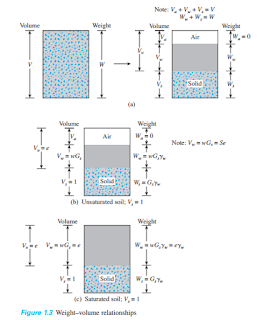ATTERBERG LIMITS:
When a clayey soil is mixed with associate degree excessive quantity of water, it's going to flow sort of a liquid.If the soil is bit by bit dried, it'll behave sort of a plastic, semisolid, or solid material, depending
on its wet content. The wet content, in percent, at that the soil changes from
a liquid to a plastic state is outlined because the liquid limit (LL). Similarly, the wet content,
in percent, at that the soil changes from a plastic to a solid state and from a solid
to a solid state area unit outlined because the plastic limit (PL) and therefore the shrinkage limit (SL), severally.
These limits area unit mentioned as Atterberg limits (Figure one.4):
• The liquid limit of a soil is decided by Casagrande’s liquid device (ASTM take a look at
Designation D-4318) and is outlined because the wet content at that a groove
closure of twelve.7 metric linear unit happens at twenty five blows.
• The plastic limit is outlined because the wet content at that the soil crumbles once
rolled into a thread of three.18 metric linear unit in diameter (ASTM take a look at Designation D-4318).
The shrinkage limit is outlined because the wet content at that the soil doesn't
undergo to any extent further modification in volume with loss of wet (ASTM checkDesignation D-427).The distinction between the liquid limit and therefore the plastic limit of a soil is outlined because theplasticity index (PI), or
LIQUIDITY INDEX:
The relative consistency of a cohesive soil within the state may be outlined by a quantitative relation
called the liquidity index, that is given by
called the liquidity index, that is given by
where w in place wet content of soil.
The in place wet content for a sensitive clay is also larger than the liquid limit.
In this case,
The in place wet content for a sensitive clay is also larger than the liquid limit.
In this case,
LI > 1
These soils, once remolded, will be remodeled into a viscous type to flow sort of a
liquid.
liquid.
Soil deposits that area unit heavily overconsolidated might have a natural wet content
less than the plastic limit. during this case,
less than the plastic limit. during this case,
LI < 0






















